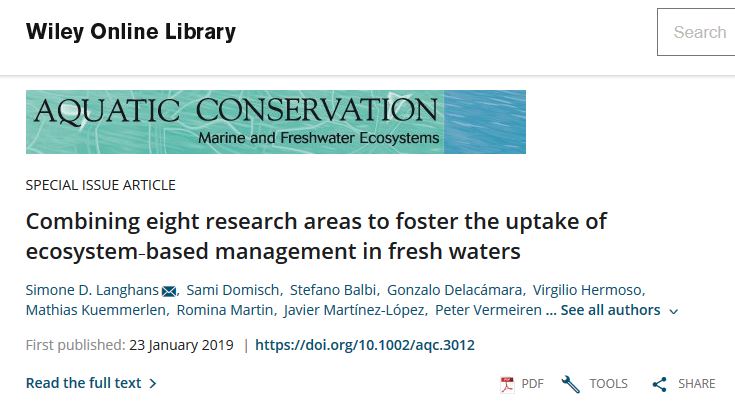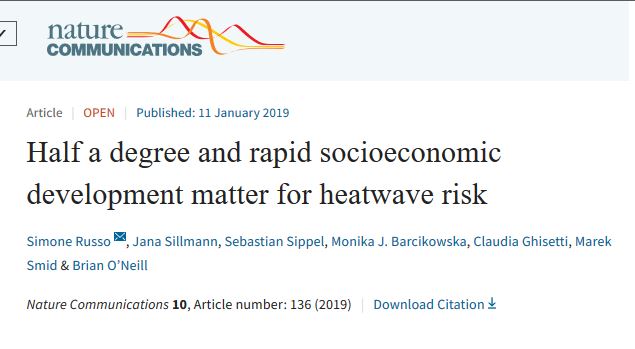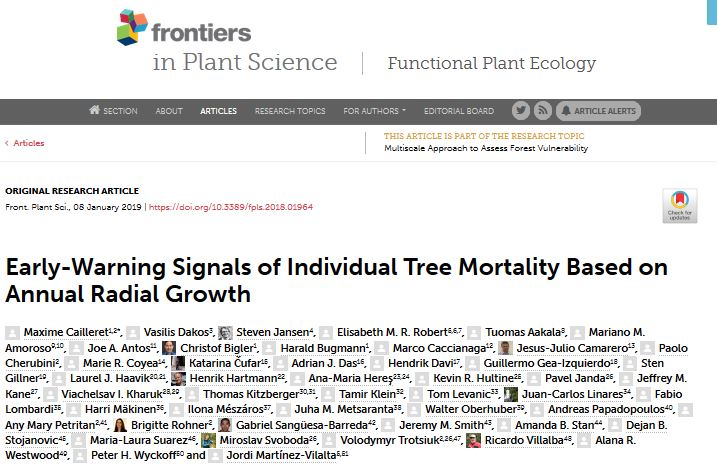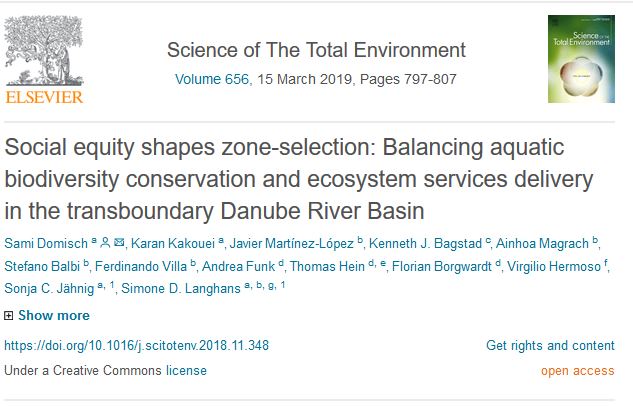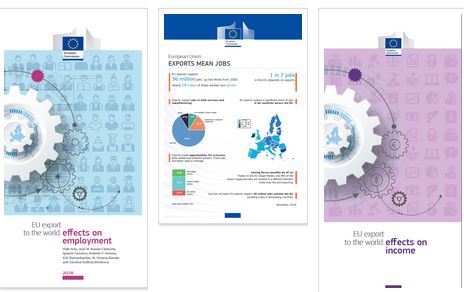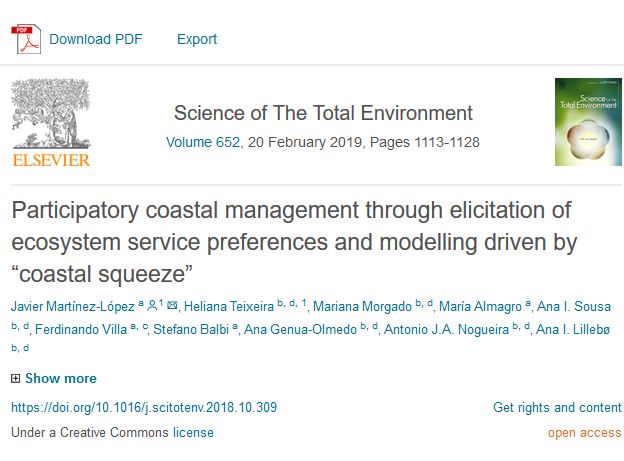Publications
January 25, 2019
Published by BC3Research Simone Langhans Stefano Balbi Javier Martínez López Ferdinando Villa at January 25, 2019
Categories
Freshwater ecosystems are under a constant risk of being irreversibly damaged by human pressures that threaten their biodiversity, the sustainability of ecosystem services (ESs), and human well‐being. Despite the implementation of various environmental regulations, the challenges of safeguarding freshwater assets have so far not been tackled successfully.
Do you like it?
January 17, 2019
Published by BC3Research Marek Smid at January 17, 2019
Categories
While every society can be exposed to heatwaves, some people suffer far less harm and recover more quickly than others from their occurrence. Here we project indicators of global heatwave risk associated with global warming of 1.5 and 2 °C, specified by the Paris agreement, for two future pathways of societal development representing low and high vulnerability conditions.
Do you like it?
January 8, 2019
Published by BC3Research at January 8, 2019
Categories
Tree mortality is a key driver of forest dynamics and its occurrence is projected to increase in the future due to climate change. Despite recent advances in our understanding of the physiological mechanisms leading to death, we still lack robust indicators of mortality risk that could be applied at the individual tree scale. Here, we build on a previous contribution exploring the differences in growth level between trees that died and survived a given mortality event to assess whether changes in temporal autocorrelation, variance, and synchrony in time-series of annual radial growth data can be used as early warning signals of mortality risk.
Do you like it?
January 3, 2019
Published by BC3Research Noelia Zafracalvo Eneko Garmendia Unai Pascual Ignacio Palomo at January 3, 2019
Categories
The Convention on Biological Diversity Aichi Target 11 requires its 193 signatory parties to incorporate social equity into protected area (PA) management by 2020. However, there is limited evidence of progress toward this commitment. We surveyed PA managers, staff, and community representatives involved in the management of 225 PAs worldwide to gather information against 10 equity criteria, including the distribution of benefits and burdens, recognition of rights, diversity of cultural and knowledge systems, and processes of participation in decision-making.
Do you like it?
December 20, 2018
Published by BC3Research Ferdinando Villa Stefano Balbi Ainhoa Magrach Maria Almagro Javier Martínez López at December 20, 2018
Categories
Five new publications related to ARtificial Intelligence for Ecosystem Services (ARIES) applications have been recently published on a special issue of Science of the Total Environment. These publications have been developed by BC3 researchers Ferdinando Villa, Stefano Balbi, Ainhoa Magrach, María Almagro and Javier Mártinez, in collaboration with other researchers from other institutions belonging to the AQUACROSS project
Do you like it?
December 20, 2018
Published by BC3Research Javier Martínez López Ainhoa Magrach Stefano Balbi Ferdinando Villa Simone Langhans at December 20, 2018
Categories
Freshwater biodiversity is declining, despite national and international efforts to manage and protect freshwater ecosystems. Ecosystem-based management (EBM) has been proposed as an approach that could more efficiently and adaptively balance ecological and societal needs. However, this raises the question of how social and ecological objectives can be included in an integrated management plan. Here, we present a generic model-coupling framework tailored to address this question for freshwater ecosystems, using three components: biodiversity, ecosystem services (ESS), and a spatial prioritisation that aims to balance the spatial representation of biodiversity and ESS supply and demand.
Do you like it?
November 27, 2018
Published by BC3Research Iñaki Arto Ignacio Cazcarro at November 27, 2018
Categories
The report features a series of indicators to illustrate in detail the relationship between trade and employment for the EU as a whole and for each EU Member State using the new World Input-Output Database (WIOD), 2016 release, as the main data source. This information has been complemented with data on employment by age, skill and gender from other sources such as EUKLEMS. All the indicators relate to the EU exports to the rest of the world so as to reflect the scope of EU trade policymaking.
Do you like it?
November 20, 2018
Published by BC3Research Javier Martínez López Stefano Balbi Ainhoa Magrach Ferdinando Villa at November 20, 2018
Categories
Large river-floodplain systems are hotspots of biodiversity and ecosystem services but are also used for multiple human activities, making them one of the most threatened ecosystems worldwide. There is wide evidence that reconnecting river channels with their floodplains is an effective measure to increase their multi-functionality, i.e., ecological integrity, habitats for multiple species and the multiple functions and services of river-floodplain systems, although, the selection of promising sites for restoration projects can be a demanding task.
Do you like it?
November 20, 2018
Published by BC3Research Javier Martínez López Stefano Balbi Ferdinando Villa at November 20, 2018
Categories
Green and Blue Infrastructure (GBI) is a network designed and planned to deliver a wide range of ecosystem services and to protect biodiversity. Existing GBI designs lacked a systematic method to allocate restoration zones. This study proposes a novel approach for systematically selecting cost-effective areas for restoration on the basis of biodiversity, ecosystem services, and ecosystem condition to give an optimal spatial design of GBI.
Do you like it?
November 20, 2018
Published by BC3Research Javier Martínez López Maria Almagro Ferdinando Villa Stefano Balbi at November 20, 2018
Categories
The Baixo Vouga Lagunar (BVL) is part of Ria de Aveiro coastal lagoon in Portugal, which is classified as a Special Protection Area under the European Habitats and Birds Directives. This part of the system, corresponding to the confluence of the Vouga River with the lagoon, is very important culturally and socioeconomically for the local communities, taking place several human activities, especially agriculture.
Do you like it?

